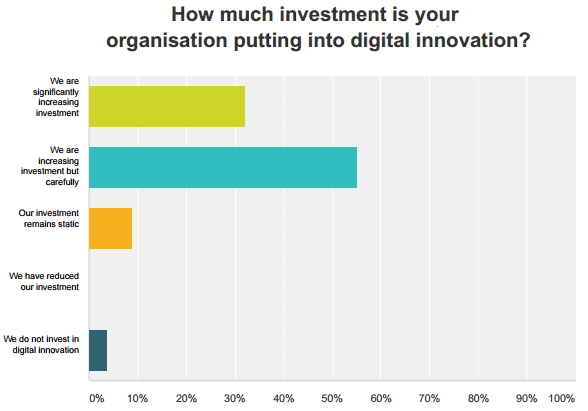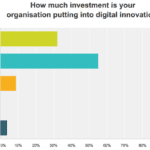Having asked our retailers to define innovation we asked them what they thought of their position as innovators and the challenges they faced.
Our results show that retailers seem confident of how well they are innovating with nearly half of all respondents saying that they were either leading, or were part of the leading pack of retailers when it came to digital innovation.
Just over one in five (21%) claimed to be leaders in innovation whilst just under over one in four (26%) said that they were part of the leading pack of retailers in terms of innovation. More than a third (35%) said that they were fast followers.
However the survey also showed that there were some retailers who weren’t so confident in their position as digital innovators. 13% of respondents said that they were well behind the competition for innovation whilst 7% didn’t see themselves as innovators at all and instead simply defined themselves as user/operators rather than innovators.
But retailers know that they need to keep up with disruption from existing competition with that cited as the biggest source of market pressure to change amongst those surveyed, according to 36% of respondents. Disruption from digital start-ups was the second biggest pressure at 32% followed by other industries diversifying into their sector for 21% of respondents.
Digital innovation doesn’t come cheap however. Our survey showed that retailers are increasingly recognising the need to invest but differed in terms of how much resource they were putting into innovation.
The majority are measured in their investment with more than half of respondents (55%) saying that they are increasing investment cautiously but nearly a third (32%) said that they are significantly increasing investment in this area. Investment remained static for 9% of respondents whilst only 4% said they aren’t investing in innovation at all.
For those who are increasing investment in digital innovation the top three areas of spending were on new tools for 58%, internal staff for 55% and infrastructure modernisation for 53%.
However retailers have to ensure they get the balance of innovation investment right – both for smaller businesses with limited resources but also larger businesses that have to be careful they don’t lose their focus. “It’s about not doing innovation for innovation’s sake – that’s the core message,” says Annabel Kilner, UK country manager for Made.com. “It’s about getting the right business case,” she says.
INNOVATION CHALLENGES
There are many challenges faced by retailers in terms of digital innovation and in our in-depth interviews with retailers we asked what the main ones they faced were. A number of common themes were identified.
“It’s amazing to hear how many of us are all in the same boat with digital innovation but just seemingly at different stages. It’s the similar constraints around budget, resource, technology and understanding your data,” says Tom Murrell, head of web development at Walls and Floors.
1) RETAINING FOCUS AND BEING PRIORITY LED
One of the biggest challenges of digital innovation can be getting carried away with what you are doing. “With so much innovation and testing that could be done you need to maintain focus on the customer and that user journey,” says Murrell. “I’ll continually ask myself what is the impact of this on the customer, the end user and what potential does this have- what can this do for sales and revenue? What is our overall goal here and where does this fit in terms of other priorities,” he says.
Schuh head of ecommerce and customer service Sean McKee agrees: “It’s about keeping up with all of the innovations you could do and making decisions on what to do and then getting it done. That remains the single biggest challenge,” he says.
Sam Barton, head of user experience at ShopDirect, says this means a clear customer understanding and focus is vital. “There is innovation everywhere so if you are not clear about who your customer is or what you want to achieve you can spend a lot of time or money on something that is not relevant to your customer. It’s easy to get carried away with gizmos and gimmicks,” he says.
Jack Smith, digital director at New Look, says retailers must focus on the end benefit to the consumer to avoid distracting from day to day business. “We have to be on top of not falling apart in some of the core expectations. That’s why I don’t really like the sexy stuff so much since that doesn’t really meet the customers’ needs,” he says. Smith cites the examples of ibeacons. “There’s nothing innovative around them because there aren’t really any examples of where it’s unlocked a customer need. Having proximity based stuff is gimmicky and gimmicks aren’t innovation because they don’t add value,” he says.
2) …BUT NOT BEING AFRAID TO FAIL
Retailers have to have a testing mentality if innovation is to thrive. “No-one wants to fail but if you’re not failing on a small scale then you’re not learning. Once you learn what works it’s all about scaling that up and then the sky’s the limit,” says Murrell.
For many retailers this means a change of mindset with a more risk-based approach than many retailers are used to. However it does also require that retailers assess exactly how much fails they can afford in their business with an SME having to limit itself somewhat when compared to a larger, more resource-led business.
3) THE CHALLENGE OF RESOURCES
Innovation naturally takes resources – in terms of money, time and effort. In our survey nearly two-thirds (64%) of respondents said that budget was the biggest IT barrier they faced in terms of being able to adopt a digital innovation strategy.
In some businesses this can be lacking due simply to the age or financial ill-health of a business or in others strained simply by the fact that it’s a smaller business without the wider resources of its bigger peers.
As an SME FreestyleXtreme’s co-founder and marketing director Ben Robert Richardson says it’s a problem he faces and requires a clear focus of resources on what will deliver the best return in terms of innovation. “Balancing the books to rapidly grow and be profitable at the same time is very hard,” he says. “We have no shortage of ideas to innovate. In fact we have walls of ideas that would take the business forward at a million miles an hour, but we only have so many hours,” he says. He says this means refining exactly what innovative ideas to focus on. “We have found it better to do less and deliver excellence rather than do more and never quite get anything over the line,” he says.
Whilst some companies have innovation labs where regular test and fail is an option for smaller businesses there is less flex. “If you can have an innovation lab in your business that’s fantastic but for our size business that doesn’t work. Our ability to fail and say that was learning is limited so we have to make the calls as best we can,” says Schuh’s McKee.
Even larger companies, such as ShopDirect, have to make the right call on where to invest resources. “We have embedded innovation in our process of ecommerce but it’s about how do you ensure you give your people the resources, capability and ability to innovate in that space,” says Sam Barton, head of user experience at ShopDirect.
4) NEED FOR COLLABORATION
But of course great innovation requires great collaboration with those involved in innovation needing to work with colleagues throughout a business – not only to cultivate and share great new innovative ideas but also to help enable them to happen too. True digital innovation requires that all departments work together and share ideas rather than working in the traditional, restricted silos of the past.
And it’s a priority that needs to be led from board level too. At Walls and Floors Murrell says this is key. “Having the support of directors has been important,” he says.
Many businesses – including the likes of New Look, Schuh and ShopDirect — don’t even like to talk about innovation as a separate word in their business but instead as an embedded part of their culture. “Innovation is led from the top but we don’t talk about it in terms of innovation. Our managing director describes it as constantly sharpening our pencil so we think of it as a customer experience question rather than an innovation question,” says McKee.
In our survey we asked retailers how much of a priority they felt digital innovation was to their organisation at board level. Encouragingly the survey showed only 3% didn’t have digital innovation as a board level priority. Instead nearly a quarter (23%) had it as their number one board priority and 58% had it as one of their top three priorities within the business. More encouragingly that innovation is starting to be a natural way of doing business was the fact that 15% of those surveyed had fully integrated digital innovation into all their activities and so didn’t treat it as a separate topic within their business.
5) MANAGING DATA
Huge innovation can come simply from better managing, analysing and using data that many businesses already hold before they even start trying to pick out more from their business but this is no easy task.
“I recently did a talk about our digital transformation at Walls and Floors over the past five years and my key message was to gather and use your data,” says Murrell. “If you can’t, find someone that can. Make data meaningful, actionable and see the difference,” he says. “Data is easy to collect, the trick is understanding it, utilising it and then communicating it. Don’t just sit back. Drive change and make a difference,” he says.
At Boots UK Robin Phillips, director of omnichannel and development, says better managing and analysing its data is crucial for Boots’ future digital innovation development, especially given the potential for Boots in health monitoring and the data involved in that. “Building an ecosystem around that is the challenge. A lot of the sexy stuff gets the headlines but it’s about how do you integrate the data at the back and how are you able to process lots of data really quickly and make sense of it,” he says.
6) PICKING THE RIGHT TIME TO INTRODUCE INNOVATION
A number of retailers we spoke to at the interview stage also warned that retailers have to be careful that they get the timing right when introducing new innovation into their businesses – particularly when that involves technology. “It’s when you bring in something too big that it becomes a problem so when you get digital innovation right it’s awesome but if you do it too early you can damage the quality of the user experience,” says Made.com’s Kilner.
She cites the use of technology such as Google Cardboard. “That will be awesome eventually but I don’t think the experience is good enough for the consumer at the moment,” she says.







